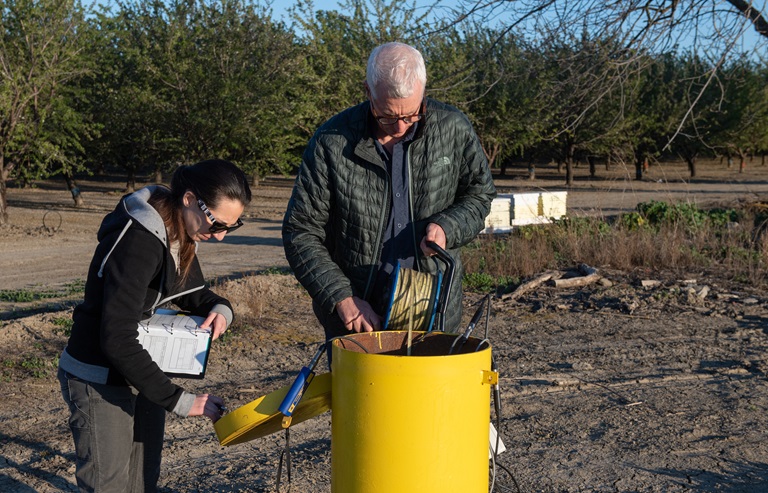Major Milestone to Achieving Sustainable Groundwater Management
DWR geologists measure groundwater levels at designated monitoring wells in Yolo County in early 2020. File photo.
This month, California’s efforts toward improving the management of our state’s critical groundwater supply is taking an important step forward. The Department of Water Resources (DWR) is releasing the determinations and written assessments for dozens of plans submitted for review in 2020.
In 2014, the State enacted historic legislation – the Sustainable Groundwater Management Act (Act) – that directed the creation of new local public agencies and their development of sustainability plans in 94 of the State’s most impacted groundwater basins, where management of the water beneath the ground needed greater oversight after decades of continued pumping. The law made local control a priority, putting decision-making and planning in the hands of local groundwater sustainability agencies – or GSAs – to set and achieve sustainability goals for each basin over a 20-year period. DWR plays a regulatory role in evaluating the local plans for likelihood of success and providing State support through data, tools, and financial assistance. Over the past six years, the local GSAs, interested groundwater users, and communities have been hard at work in laying the foundation for developing the first-ever groundwater sustainability plans – or GSPs – and beginning to progress towards sustainable groundwater management. These management decisions are significant, where communities, households, businesses, and California’s vast agricultural industry all rely on groundwater.
To ensure the health and reliability of the State’s groundwater resources and to continue to provide for resilient communities and economic vitality across California, the Department is marking a major milestone in advancing this effort. DWR had a two-year review period under the Act to evaluate the feasibility and sufficiency of the first 42 plans, covering 20 basins, the majority of which are California’s critically overdrafted basins. In June and November 2021, DWR issued official ‘Approved’ determinations for six basins to help communicate findings early to locals.
Throughout the month of January 2022, DWR will release the official determinations of the remaining plans that were submitted to the State for review in 2020. In a three-phased release approach, the Department will share the results of the technical review for the plans in 14 basins, primarily located in the San Joaquin Valley. The first phase, released on January 13, includes two approved determinations for the plans in the Las Posas Valley Basin in Ventura County and the Indian Wells Valley Basin primarily located in east Kern County. These GSAs will need to continue implementing their plans, through the monitoring of groundwater levels and conditions, analyzing climate conditions, and identifying and avoiding impacts through the development of projects and actions to help create a more reliable water supply for their region. Over the implementation period, it is expected that plans adapt to changing conditions and the severity of climate change. The second and third phases will be released over the next several weeks, resulting in all official determinations on these first plans being made available by the end of the month.
Local agencies can anticipate one of three outcomes from the Department in their review, including Approved, Incomplete, or Inadequate determinations. With Approved plans, locals must continue working to fill data gaps and progress in implementing their planning efforts. In basins where plans are considered Incomplete, GSAs must work locally, with all interested parties, to correct the deficiencies identified by DWR within 180 days from the issuance of the final determination, as required by the Act. Lastly, if a plan is determined Inadequate by DWR, the Department will consult with the State Water Resources Control Board, who has the authority to intervene and help basins get back on track towards sustainability.
The Department acknowledges the tremendous efforts put forth by local agencies to develop these initial GSPs. DWR recognizes no plan is perfect and that these plans represent significant efforts to change how groundwater is monitored, managed, and used. These plans provide a roadmap for how groundwater basins will reach long-term sustainability and agencies are expected to continually gather the latest information to fill data gaps, update plans, and practice science-based adaptive management. DWR's ongoing responsibility after the initial plan assessment includes reviewing annual reports and assessing each plan every five years to determine if the GSAs are on track to meet their basin’s sustainability goals. Additionally, the Department anticipates approximately 70 to 90 plans from approximately 63 more basins to be submitted by January 31, 2022 for review within the next two years by 2024.
This shift in groundwater management is paramount for California to have reliable groundwater resources now and into the future, in particular, during dry or drought years when there is less precipitation and snowpack and increasing groundwater use serves as a drought buffer. The unprecedented drought conditions in 2021 were a stark reminder of how quickly water supply conditions can change in California, especially under the influence of climate change. Protecting our groundwater resource over the long-term is the foundation of SGMA and a key component to maintaining a secure water supply for all Californians, the environment, industries, and our economy.
